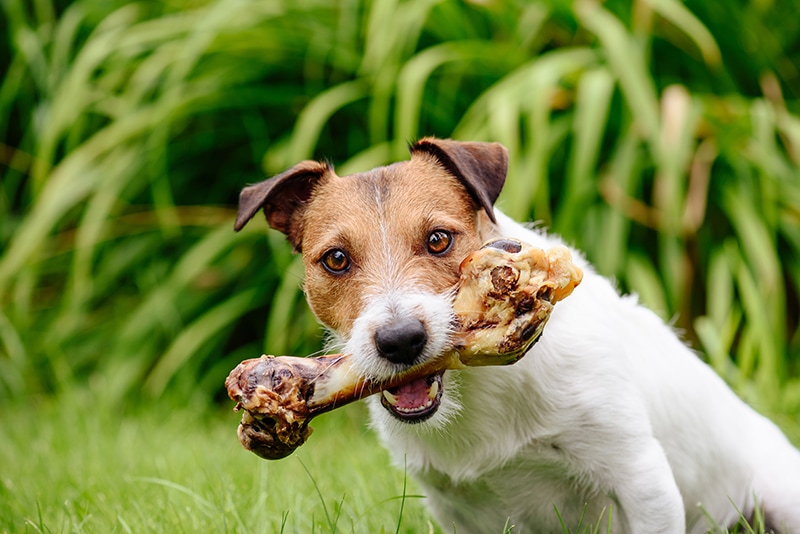[ad_1]
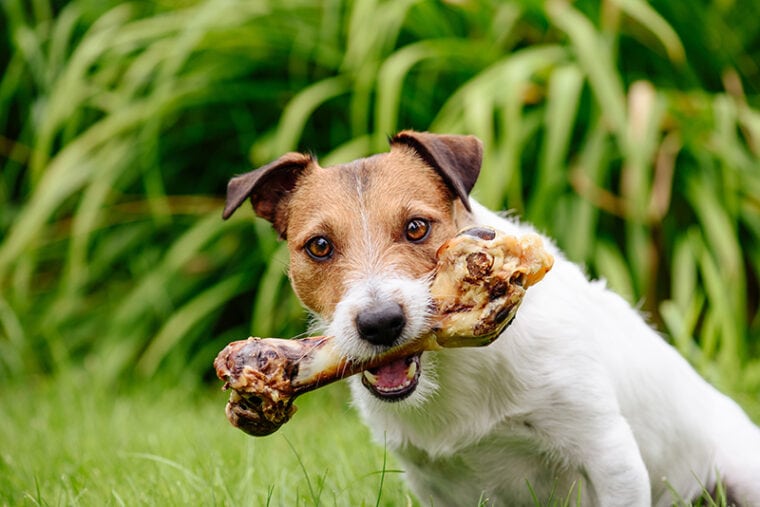
It seems natural that dogs and bones should go hand-in-hand (or rather paw-in-mouth). But despite their begging demeanor and your impulse to give in to it, not all dogs should be given a bone.
The right bones make an excellent treat for pups that are suitable candidates for having bones as a dental chew. However, whether or not your pup can be given a bone depends on their personality and chewing habits and is something you should discuss with your vet.
That’s why it is impossible to tell if bones are okay for your pup until a veterinarian or dog trainer assesses them on an individual basis. In this article, let’s examine how to tell if your dog might be a potential candidate for receiving a bone, and the types of bones such a dog should be given.
Are Bones Okay For My Dog?
Certain raw bones can make an excellent dental chew for some dogs. Not only do bones provide such dogs with enrichment and a way to beat boredom, but they also help control tartar.
However, not all dogs should be given bones. Dogs that are overly ambitious chewers, quick eaters, and excessively hyper may suffer injuries if given a bone. For such dogs, biting on a bone too hard may result in dental injuries, injuries to their gums, and other injuries in their oral cavity. Extremely ambitious chewers may break a bone and swallow a small piece. This is dangerous, as the bone may become a choking hazard, lodge somewhere along their digestive tract, or even perforate parts of the tract.
In addition, puppies shouldn’t be given bones, as their deciduous teeth (also known as milk teeth) are softer than adult teeth, and therefore more prone to injury from biting down on a bone.
Toy and miniature breeds usually struggle with large bones as well. As a general rule, bones offered to dogs shouldn’t exceed the size of their heads.Furthermore, if your dog is under medication or ill (especially with a gastrointestinal issue) – always double check with your vet before giving them a bone (even if they were fine with bones before).
Finally, the most important factor when deciding if your dog is a suitable candidate for a bone is to ask your vet. Your vet will help you make this decision based on your dog’s breed, age, size, any underlying health issues, and information about their personality and chewing habits. Offering your dog a bone of any kind before consulting with your veterinarian is strongly discouraged.
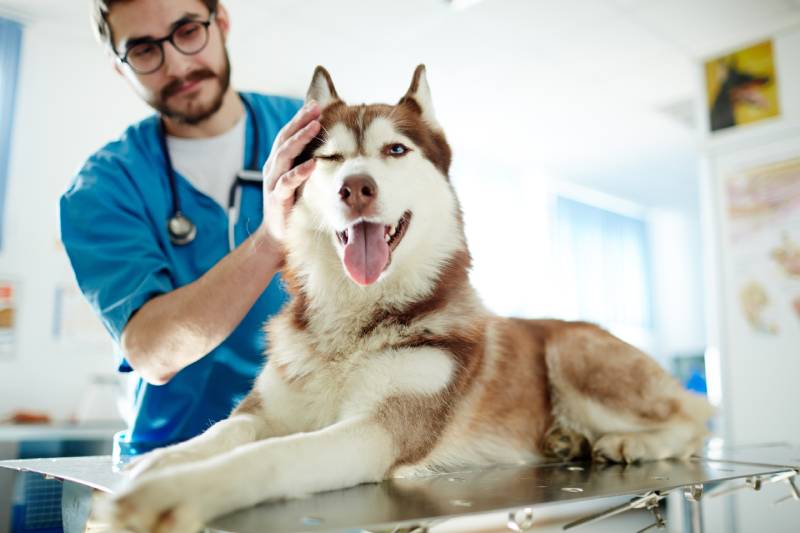
Types of Bones Safe for Dogs
If your vet determines that your dog is a suitable candidate for having bones, you should still proceed with caution and observe them with the bone at all times. Ask your vet for advice on which bones are best for your dog.
When considering which type of bone is the safest for your canine friend, choose raw over cooked bones. Avoid feeding cut or split bones, and once the bone is gnawed to the brittle hard part, your dog risks making splinters, so replace it.
While maintaining the rule of raw bones only, the safest bones you can give to your dog (factoring in their size) include:
Choose large thick bones instead of narrow small ones as your dog is less likely to chew these into shards or tiny swallow-able pieces. But avoid giving your four-legged pal a bone if they suffer from digestive issues such as frequent diarrhea or irritable bowel syndrome, IBS, as the marrow’s richness may exacerbate such problems.
Remember that bones are a complement or treat after food and shouldn’t be an alternative or supplement. Therefore, try minimizing the amount you’ll offer, and limit gnawing time to five or ten minutes if it’s their first time chewing on a bone.
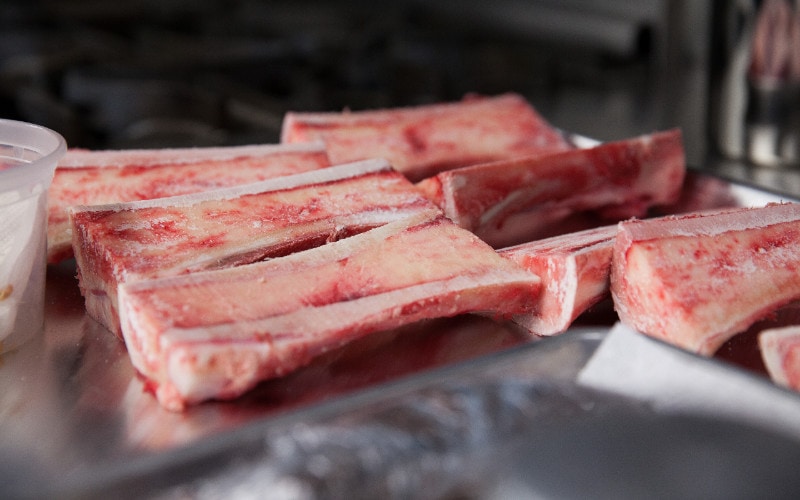
How to Tell If the Bone You’re Feeding to Your Dog Is Safe
If you ask your dog, there’s no good or bad bone, so it’s up to you to use discretion when selecting the best bones that you can safely feed. Once you’ve eliminated the risk with factors like size, brittleness, and breakability, you’ll pick the safest bone if you know what aspects to look for.
Which Bones Pose a Threat to My Dog?
Monitoring your dog while they’re chewing bones is essential since even raw ones can have disastrous results on your pooch’s health. In addition, there’s no safe bone for some dogs, as gnawing on a large, round knucklebone can cause broken teeth.
Dogs chew bones differently according to their personality, and if your mutt is a chomper or quick chewer, small pieces or splinters can become choking hazards.
Raw bones may also harbor food-borne pathogens like salmonella if left outside for an extended period, which is dangerous for immuno-compromised pets and persons in your household. However, when faced with the lesser of two evils, go for uncooked bones instead of cooked ones as these pose less danger.
Due to the brittleness created by cooking, your dog’s chewing broken shards from cooked bones will risk internal injuries when fragments get stuck in the intestines. Not only can that cause constipation and blockage, but intestinal damage will also lead to costly vet visits that may result in surgery.
Besides broken teeth, constipation, and gastrointestinal blockage, other hazards that come from cooked brittle bones include:
Bones to Avoid
Are There Benefits to Giving My Dog Bones?
Bones are tough and long-lasting, meaning they’ll keep your dog busy chewing for long, but mainly for recreation and not for express nourishment.
Chewing is also one way to provide a healthy outlet for your canine. Studies show there’s a release of happy hormones in your dog when they chew, which helps curb aggressive behavior.
Furthermore, occasionally chewing on the right bone helps your dog clean their teeth and prevents plaque buildup, reducing chances of gum disease. However, bones shouldn’t replace regular brushing and vet teeth cleaning visits if you’re to maintain your dog’s dental hygiene.
Although bones contain trace nutrients like phosphorus and calcium, your dog should refrain from swallowing any of the shards since these may pose a challenge to digest. Instead, nutritional benefits are derived from any attached soft tissue like meat, cartilage, or internal marrow that provides fats, vitamins, and proteins. If you intend to feed your dog bones (as part of a raw diet), the bones should be finely ground and mixed into their food. Always consult with a canine nutritionist and your vet prior to transitioning your dog to a raw meat based diet.
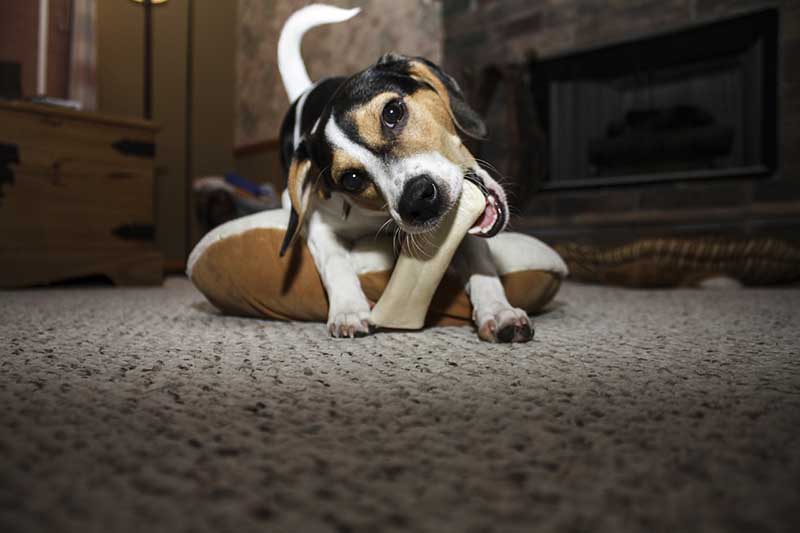
How to Store Raw Bones for Your Dog
Freezing is the best storage method for raw bones, especially natural ones with some residual flesh tissue on them. You can then refrigerate or thaw the bone before offering it to your dog, ensuring that the surface on which they gnaw their treat is also clean.
When you decide that your dog has had enough for the day, you should gently wipe the bone before putting it back in the fridge or freezer. Use a bag or container to separate human and dog food so there’s no contamination or use a separate unit.
Tips for Keeping Your Dog Healthy, Safe, & Happy
Besides choosing the best bones to feed your dog, you should be proactive about their health, safety, and happiness in your household. Allowing them sufficient bone-chewing time is a great start, but you can also do the following:
Conclusion
Deciding if bones are appropriate for your dog requires the input of your veterinarian or a dog trainer. If your dog is a suitable candidate for bones, there are several options to choose from. You can safely feed your dog with appropriately-sized raw beef or lamb bones if they’re thick, dense, and larger than your dog’s muzzle. That’s so the bone won’t break or splinter into dangerous shards, and there’s a lower risk of swallowing. Dogs should always be monitored when they’re chewing on bones.
Avoid brittle and easy-to-break bones such as poultry and some pork chops, especially if your dog’s size means it can easily swallow them. Ingested bones pose a health threat to dogs, including injury or punctures to their mouths, stomach, and intestinal tract.
Featured Image Credit: alexei_tm, Shutterstock
